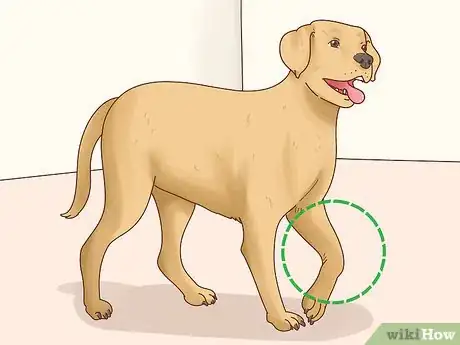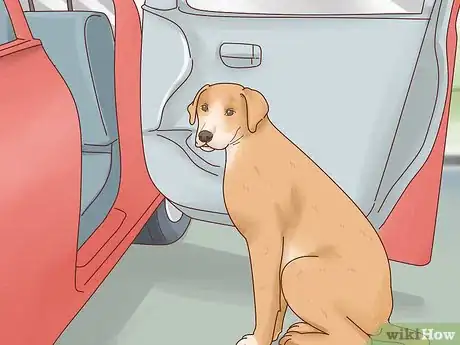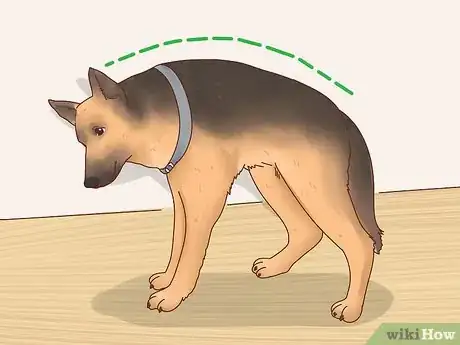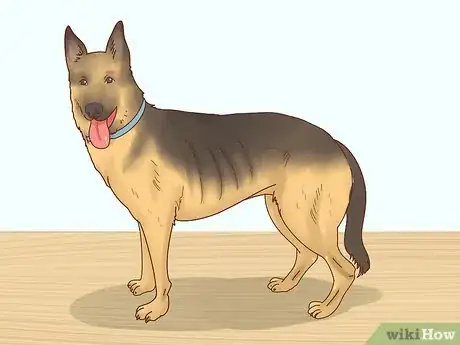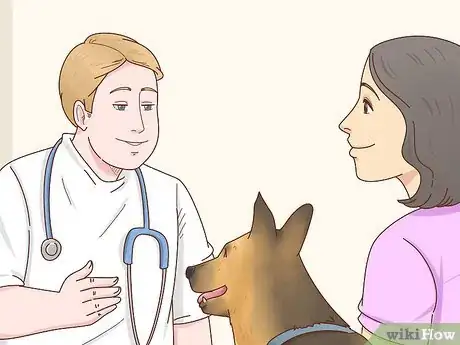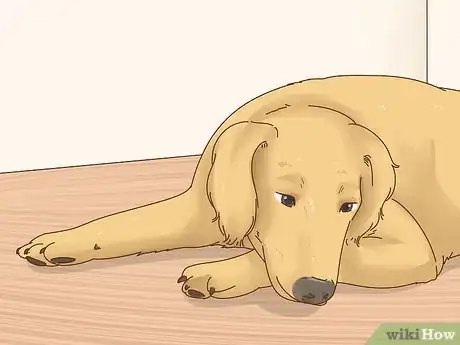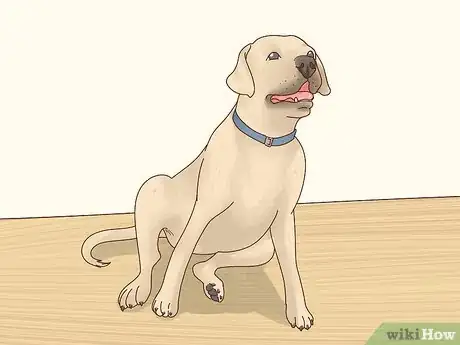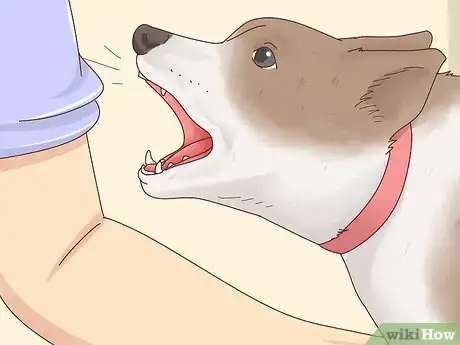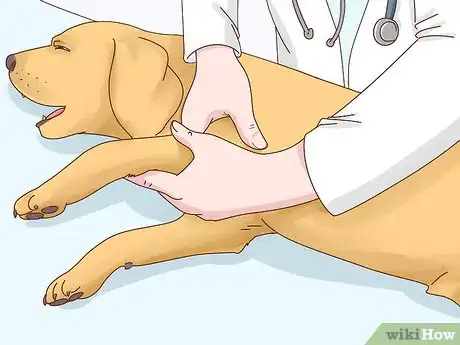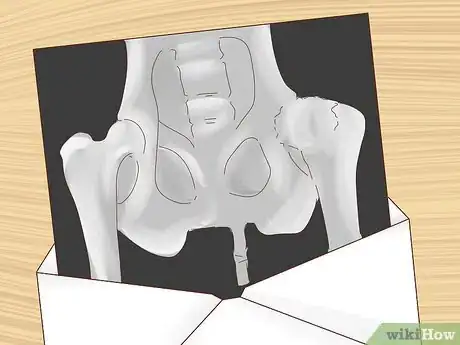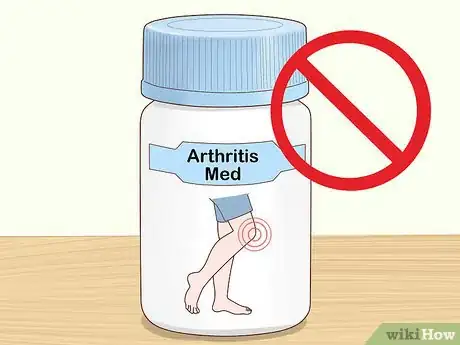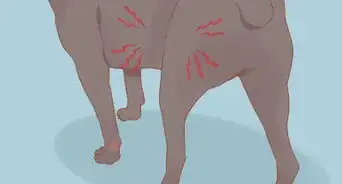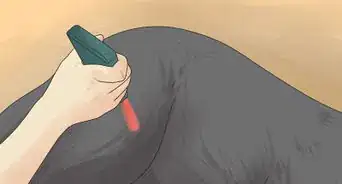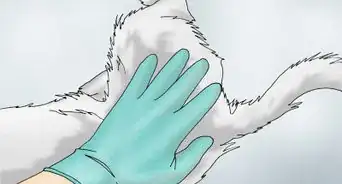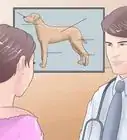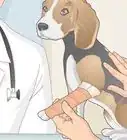This article was co-authored by Melissa Nelson, DVM, PhD. Dr. Nelson is a Veterinarian who specializes in Companion and Large Animal Medicine in Minnesota, where she has over 18 years of experience as a veterinarian in a rural clinic. She received her Doctor of Veterinary Medicine from the University of Minnesota in 1998.
There are 11 references cited in this article, which can be found at the bottom of the page.
This article has been viewed 32,809 times.
Diagnosing a dog with arthritis begins at home. That is, you're more likely to notice changes in your dog's body and behavior than your vet is because you see your dog every day. There are 2 types of arthritis that dogs can develop: osteoarthritis and inflammatory arthritis.[1] Once you suspect your dog has one of these forms of arthritis, talk to your vet about further ways to diagnose the condition.
Steps
Paying Attention to Changes in Your Dog's Body
-
1Watch for limping in the morning. Arthritis in dogs often displays as your dog limping. For instance, your dog may favor one leg if it is hurting more. This symptom is likely to be more noticeable when your dog first gets up, as moving around a bit can ease some of the stiffness.[2]
-
2Notice reluctance to move certain ways. If your dog has arthritis, it may not want to move around as much. You may notice it doesn't want to jump in the car, for instance. If that's something it used to do regularly, that could indicate your dog has arthritis.[3]
- You may also notice that your dog isn't able to walk for as long as it used to.
Advertisement -
3Look for problems with the spine. Arthritis can also present in the back or hips, not just the legs. You may notice that your dog develops a hunch back, for instance, or that one of its back legs starts dragging a bit. You might also notice sensitivity in the neck area, where pain can develop.[4]
-
4Check for loss of muscle mass. Another symptom of arthritis in dogs is the loss of muscle mass over time. Your dog may lose muscle mass because it's not using its muscles as much. Your dog may look skinnier or not as bulky when it loses muscles, though your dog may also gain more fat due to less activity. One management for arthritis is helping your dog build muscle mass.[5]
Looking for Changes in Your Dog's Behavior
-
1Watch for changes in your dog's appetite. A dog doesn't feel good when it's in pain, and when your dog doesn't feel good, it doesn't want to eat. Therefore, you may notice a decrease in your dog's appetite if it has arthritis, although this symptom alone can indicate any number of conditions, not just arthritis.[6]
-
2Don't ignore odd behavior. Any kind of odd behavior for your dog could indicate arthritis. One of the main kinds of odd behavior your dog may display is it suddenly having more accidents around the house, likely because it doesn't want to make the painful trip outside.[7] You may notice other signs, such as less excitement about going on a walk. If you feel like something just isn't right with your dog, you should have vet evaluate it.
-
3Pay attention to your dog being more tired. Many things can make your dog more tired, so tiredness alone does not indicate arthritis. However, taken in conjunction with other symptoms, tiredness can be a symptom of arthritis, so be on the lookout for it. For instance, your dog may not have much interest in playing.[8]
- Your dog may gain weight, in fact, because it's not moving around as much.[9]
-
4Look for odd positions when your dog is sitting or lying down. Your dog is going to try to get comfortable, despite the pain. You may notice it roll around more or end up in very odd positions to try to get more comfortable for sleeping. If you notice some new sleeping or sitting positions for your dog, that may indicate it's in pain.[10]
-
5Listen for whimpering. You may notice that your dog is whimpering or whining more as it moves around. Just like humans, dogs will complain about pain, and they do it by making these noises. If you notice your dog is whining more, you may need to talk to your vet.[11]
- Other dogs may take to growling more, especially if they're touched in spots that are painful for them.
-
6Notice crankiness. Your dog doesn't like to be in pain any more than you do. Therefore, when it's in pain from arthritis, you may notice that your dog is crankier. For example, your dog may snap at you, particularly if you pet an area that's in pain.[12]
Diagnosing Your Dog With Your Veterinarian
-
1Talk to your veterinarian. If you suspect your dog has arthritis, it's important to discuss it with your veterinarian. Your veterinarian can make sure it's arthritis and not something else, as well as provide ways to help manage pain.[13]
-
2Expect a physical exam. Part of diagnosing your dog will include the veterinarian giving your dog a physical exam. Basically, your vet will visually inspect the dog, as well as feeling the dog in several places (like joints) to help determine the cause of the pain.[14]
- Your vet will also use things like your dog's past medical history and age to help determine if your dog has arthritis.
- Bring a list of symptoms you've noticed in your dog to help your vet diagnose the problem.
-
3Ask about x-rays. Often times, a vet will give your dog x-rays if they suspect arthritis. X-rays can help determine how bad the arthritis is in your dog, which can help decide treatment. If your vet doesn't suggest x-rays, ask if that's an option your dog needs. Keep in mind, though, x-rays will be extra as far as cost goes, especially if your dog needs to be sedated for them.[15]
-
4Don't give your dog human medications. While dogs can sometimes take human medications, it's best to talk to your veterinarian before dosing your dog with any medication. Some human medications can be harmful or even fatal to dogs, so you could unintentionally poison your dog. Any medications your dog takes should be prescribed by a veterinarian.[16]
References
- ↑ https://www.merckvetmanual.com/musculoskeletal-system/arthropathies-and-related-disorders-in-small-animals/degenerative-arthritis-in-small-animals
- ↑ https://www.avma.org/public/PetCare/Pages/Caring-for-an-Older-Pet-FAQs.aspx
- ↑ https://www.avma.org/public/PetCare/Pages/Caring-for-an-Older-Pet-FAQs.aspx
- ↑ https://animal.research.uiowa.edu/oar-informational-sheet-pain-recognition-laboratory-animals
- ↑ http://csu-cvmbs.colostate.edu/vth/small-animal/sports-medicine-rehabilitation/Pages/arthritis-management-and-prevention.aspx
- ↑ https://animal.research.uiowa.edu/oar-informational-sheet-pain-recognition-laboratory-animals
- ↑ http://www.akcchf.org/canine-health/your-dogs-health/caring-for-your-dog/managing-canine-arthritis.html
- ↑ http://csu-cvmbs.colostate.edu/vth/small-animal/sports-medicine-rehabilitation/Pages/arthritis-management-and-prevention.aspx
- ↑ https://www.avma.org/public/PetCare/Pages/Caring-for-an-Older-Pet-FAQs.aspx
- ↑ https://animal.research.uiowa.edu/oar-informational-sheet-pain-recognition-laboratory-animals
- ↑ https://animal.research.uiowa.edu/oar-informational-sheet-pain-recognition-laboratory-animals
- ↑ https://www.avma.org/public/PetCare/Pages/Caring-for-an-Older-Pet-FAQs.aspx
- ↑ http://vetmed.tamu.edu/news/pet-talk/arthritis-in-dogs
- ↑ http://www.akcchf.org/canine-health/your-dogs-health/caring-for-your-dog/managing-canine-arthritis.html
- ↑ http://www.akcchf.org/canine-health/your-dogs-health/caring-for-your-dog/managing-canine-arthritis.html
- ↑ https://www.avma.org/public/PetCare/Pages/Caring-for-an-Older-Pet-FAQs.aspx
- ↑ https://www.petmd.com/dog/general-health/evr_dg_remedies_for_arthritis_in_dogs
- ↑ https://www.petmd.com/dog/general-health/evr_dg_remedies_for_arthritis_in_dogs
